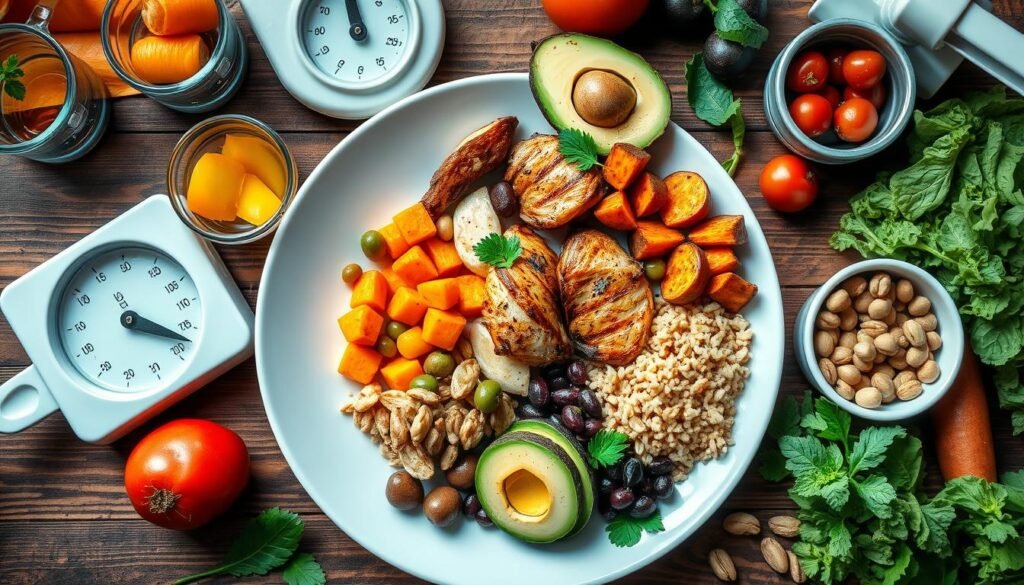Did you know bodybuilders often aim for a caloric surplus of 300 to 400 calories? They do this above their daily needs to build muscle effectively. Known as bulking, this process is vital for muscle growth and strength. In this article, we’ll fully discuss bulking. We’ll explain why it’s important for bodybuilders. Bulking isn’t just about eating a lot. It’s about eating more calories while training hard. A typical bulking phase lasts 4 to 6 months. During this time, bodybuilders work to gain muscle. However, they also expect some fat gain. This article covers bulking’s purpose, phases, diet tips, training plans, and health tips.
Key Takeaways
- Bulking generally involves a caloric surplus of 300 to 400 calories.
- Protein intake should be 1.2 to 2 grams per kilogram of body weight for effective muscle gain.
- Bulking phases can last between 4 to 6 months, focusing on muscle gain with some fat increase expected.
- Maintaining a 3:1 ratio of carbohydrates to protein post-workout aids in recovery.
- Regular training of major muscle groups, at least 3 to 4 times per week, is essential for success.
Understanding Bulking: The Basics
Bulking is a key part for bodybuilders. It means eating more calories than you burn. This helps grow muscle mass and strength.
Planning your bulking is important. Competitive bodybuilders eat up to 5,736 calories daily. An active man needs at least 2,400 calories a day. During bulking, men may eat about 3,800 calories a day, and women about 3,200.
Newcomers to strength training might not need to bulk for big muscle gains at first. But seasoned bodybuilders need extra calories to keep growing. Bulking usually goes for 4 to 6 months. Aim to gain 0.4 to 0.8 pounds weekly, which is healthy.
| Aspect | Men (Average) | Women (Average) |
|---|---|---|
| Daily Caloric Needs | 3,800 calories | 3,200 calories |
| Caloric Surplus Recommended | 10–20% | 10–20% |
| Duration of Bulking Phase | 4–6 months | 4–6 months |
| Weekly Weight Gain Target | 0.25–0.5% of body weight | 0.25–0.5% of body weight |
Bulking up is more than gaining muscle. It also sets you up for cutting phase, where you lose fat. Knowing bulking well helps you reach your bodybuilding goals.
Bulking Definition and Purpose
Bulking is all about eating more calories than your body needs to stay the same weight. It’s meant to help muscles grow. It’s not just about getting heavier. The real goal is to grow muscles and improve both how you perform and look.
People doing a bulking phase eat 10-20% more calories than usual. This extra energy helps fix and grow muscles, important for workout routines. Lots of gym-goers do this, especially with how popular bulking is on social media.
Bodybuilders usually bulk up and then cut down fat. This cycle helps them get bigger muscles first. Then, they lose the extra fat to look lean and defined.
| Aspect | Details |
|---|---|
| Caloric Surplus | Intentionally consuming more calories than required |
| Main Goal | Promote muscle growth (hypertrophy) |
| Typical Duration | Weeks to months, varies by individual goals |
| Follow-Up Phase | Cutting to reduce body fat |
| Common Misconceptions | Bulking means gaining any weight, not just muscle |
If you want to get the most out of bodybuilding, understanding bulking is key. Plan well, choose the right foods, and know your goals. This way, bulking will really help you succeed.
Stages of Bodybuilding: Bulking vs. Cutting
The journey through bodybuilding has two main parts: bulking and cutting. In the bulking phase, athletes eat more to grow their muscles. This part of training usually goes on for 3-4 months. They might gain about 15-20 lbs of muscle, along with some fat, as they aim to grow muscle by heavy lifting.
Eating the right food is key during this phase. A clean diet that’s about 110% of what they usually need helps. For someone who weighs 180 lbs, this means eating 1 gram of protein per pound. That’s roughly 720 calories just from protein each day. They also eat more carbs and healthy fats for a balanced diet.
Then comes the switch to cutting, which is all about getting lean. This stage usually lasts 8-12 weeks. The goal is to lose the extra fat gained during bulking but keep the muscle. Athletes eat slightly less, cutting 300-500 calories from their diet. This helps lose about 2 pounds per week, making sure they still eat nutritious food.
It’s crucial to get these stages right in bodybuilding. Keeping track of body changes and weight is important. Correctly managing how much you eat helps grow muscles and stops you from losing them when cutting. This means better performance in sports. To learn more about bulking vs cutting and how to adjust your food and exercise, follow the link for more details.
What is Bulking? A Deeper Look at Bulking Def
The bulking phase is key in bodybuilding. It focuses on gaining muscle. People eat more during this time, adding 300 to 600 calories to their daily diet. This helps reach the bulking goals, like bigger muscles and more strength.
Bulking as a Phase in Bodybuilding
Bodybuilders start bulking with 10% to 15% body fat. This helps grow muscles without much fat. Bulking lasts 4 to 6 months. During this, the right mix of carbs, protein, and fats is crucial. A common daily calorie goal is about 3,300.
| Macronutrient | Percentage | Grams |
|---|---|---|
| Carbohydrates | 45–60% | 370–500 |
| Protein | 30–35% | 250–230 |
| Fat | 15–30% | 55–110 |
Duration and Goals of Bulking
As you gain muscle, the pace may slow down. Cycling between bulking and cutting helps keep progress going. Bulking often happens in colder months. This lets people hide any extra fat. Beginners might see quick muscle growth at first, but it slows over time. For more details, check this resource on bulking strategies.

How to Start Bulking: Setting Up Your Caloric Surplus
Starting the bulking phase needs careful planning. This ensures muscle growth without much fat. The first step is to estimate caloric needs. It depends on weight, age, sex, and how active you are. Getting this right is key for a good caloric surplus.
Estimating Daily Caloric Needs
To bulk up, figure out your maintenance calories first. Aim for a surplus of 500 to 1,000 calories above that. This helps in gaining weight slowly, about 0.25–0.5% of your body weight each week. Say your maintenance is 3,000 calories. Then, target 3,300 to 3,600 calories daily. Don’t forget to consider your exercise and metabolic rate in your caloric needs.
Aim for 10-20% Surplus
Aiming for a 200-300 daily calorie surplus is good for steady progress. It keeps fat gain minimal and focuses on muscle. It’s also important to do plenty of resistance training. This mix of diet and exercise boosts muscle building after workouts.
Eating foods rich in nutrients, like trail mix and high-calorie sauces, helps meet bulking goals. A balanced approach supports muscle growth and health. For detailed clean bulking tips, check this comprehensive guide.
| Caloric Need | Surplus Level | Total Caloric Intake | Weekly Weight Gain Goal |
|---|---|---|---|
| 3,000 calories | 300-600 calories | 3,300-3,600 calories | 0.25-0.5% of body weight |
| 2,500 calories | 200-400 calories | 2,700-2,900 calories | 0.5-1% of body weight |
Determining Your Bulking Macros for Success
Success in bulking comes down to smart bulking macros planning. The right mix of macros helps your muscles grow. It also keeps your energy up for workouts. It’s all about finding the perfect balance for your goals.

| Macronutrient | Percentage of Total Intake | Calories per Gram |
|---|---|---|
| Protein | 30-35% | 4 |
| Carbohydrates | 45-60% | 4 |
| Fats | 15-30% | 9 |
Let’s say you need 2,580 calories a day. To bulk up, you might add 10-15% more calories. That takes you to around 2,838 calories per day. With a 40/40/20 split, you’d get 1,135 calories each from protein and carbs. You’d get 567 calories from fat.
This gives you about 284 grams each of protein and carbs. Plus, about 63 grams of fat.
Figuring out your macros also means looking at how much you move. Your activity levels influence how many calories you need. Here’s a quick way to figure it out:
- Little or no exercise: Use a multiplier of 1.2.
- Light exercise a few times a week: Use a multiplier of 1.375.
- Moderate exercise 3-5 times a week: Use a multiplier of 1.55.
- Heavy exercise 6-7 times a week: Use a multiplier of 1.725.
Staying aware of your activity and nutrition helps in bulking up. Keeping track of your bulking macros is key. Watch your weight and workout results to stay on course.
Bulking Diet: Foods to Emphasize and Avoid
The success of a bulking diet relies on food quality. Eating nutrient-dense foods aids in muscle growth and health. It’s important to focus on certain foods while avoiding others for the best bodybuilding results.
Nutrient-Dense Foods to Include
When bulking, variety is key. You should eat these foods:
- Lean proteins like chicken, turkey, and fish repair muscles.
- Whole grains such as brown rice, quinoa, and oats provide energy.
- Fruits and vegetables are packed with vital vitamins and minerals.
- Healthy fats from avocados, nuts, and olive oil boost hormones.
Foods to Limit during Bulking
Some foods can lead to unwanted fat gain. Be sure to avoid:
- Processed sugars should be minimized as they cause unhealthy weight gain.
- Deep-fried foods raise cholesterol and increase disease risk.
- Foods high in unhealthy fats can harm muscle gains and health.
A smart bulking diet boosts muscle growth and health. By balancing your nutrients and picking nutrient-rich foods, reaching bodybuilding success is possible.
| Food Type | Recommended Foods | Foods to Avoid |
|---|---|---|
| Proteins | Chicken, turkey, wild salmon | Processed meats, excessive protein bars |
| Carbohydrates | Brown rice, quinoa, sweet potatoes | White bread, sugary cereals |
| Fats | Avocados, nuts, olive oil | Trans fats, fried foods |
| Dairy | Greek yogurt, low-fat cheese | Full-fat dairy, sweetened yogurts |
Bulking Workout Plan: Training for Muscle Growth
A good bulking workout plan is key for adding muscle. It should start with compound exercises. Squats, deadlifts, and bench presses are important. They work many muscles at once, helping you get stronger and bigger.
When training for growth, hit each muscle group 2-3 times a week. Aim for 3-4 sets of 8-12 reps per exercise. This way, you stress your muscles just right for growth.
Getting stronger over time, known as progressive overload, is vital. You should lift heavier or increase resistance to grow muscles. Changing your workout every 4-6 weeks helps you keep improving without hitting a plateau.
To grow, you need to eat more calories than you burn. For muscle gain, aim for a 5-10% calorie increase. If you need 3500 calories to maintain your weight, target about 4300 calories every day. Spread this out into 7 meals, around 500 calories each, for best results.
Proper protein intake is crucial for muscle growth. Eat at least 1 gram of protein for each pound you weigh. Your diet should be about 40% carbs, 40% protein, and 20% fats. Choose complex carbs and healthy fats for energy and good health.

| Workout Frequency | Sets | Reps |
|---|---|---|
| 2-3 times a week | 3-4 sets | 8-12 reps |
| Caloric Surplus | Example Daily Caloric Intake | Protein Intake |
| 5-10% above maintenance | 4300 calories (if 3500 is maintenance) | 1 gram per pound of body weight |
| Macronutrient Distribution | Complex Carbohydrates Sources | Protein Sources |
| 40% Carbs, 40% Protein, 20% Fats | Brown rice, quinoa, oats | Fish, poultry, dairy, nuts |
Follow a solid bulking plan and stick to nutritional advice for muscle growth success.
Bulking Supplements: What to Consider
Starting a bulking journey? Choosing the right supplements can really boost the process. They help with muscle growth and recovery. Knowing about popular options and protein powder’s role is key to getting the best results.
Popular Supplements for Bulking
People often use a range of supplements to hit their calorie and nutrition targets. Here are some common picks:
- Weight Gainer Shakes: These shakes pack about 300-800 calories per serving. It’s a simple way to up your calorie intake. For example, a shake might have 365 calories, 27 grams of protein, and 52 grams of carbs.
- Creatine: It boosts your performance in short, intense workouts. This helps you train harder and increases muscle size, mostly by drawing more water into your muscles.
- BCAAs (Branched-Chain Amino Acids): Important for building muscle protein. Leucine, in particular, starts the muscle-building process.
- Beta-Alanine: This helps manage the acid that builds up during hard workouts. It can let you work out longer and build more muscle.
- Omega-3 Fatty Acids: These fats help reduce soreness after workouts, aiding in recovery and muscle health.
The Role of Protein Powder in Bulking
Protein powder is crucial in bulking. It’s an easy, effective way to meet your protein needs. A shake can have 100-150 calories and 20-30 grams of protein. That’s about as much protein as in a large chicken breast. Adding a high-quality whey protein to a balanced diet helps build lean muscle with strength training.
For a successful bulking plan, pick and use supplements wisely to boost performance. It’s important to match these supplements with your needs, how hard you train, and what you like to eat. This makes your bulking routine more effective.
Common Bulking Tips for Newcomers
If you’re new to bulking, focus on being consistent with your diet, workout, and rest. Good bulking tips can boost your outcomes and keep fat gain low.
- Maintain a Controlled Caloric Surplus: Eating about 500 calories more than you burn daily should see you gaining around 1 pound each week.
- Track Macronutrient Intake: To grow muscle effectively, aim for at least 1 gram of protein per lean pound of your weight.
- Avoid Dirty Bulking: Quick bulking might lead to eating too many calories, which adds unwanted fat.
- Start Slowly: Begin your bulking phase gradually, focusing on eating right and slowly upping your weight-lifting game.
- Prioritize Meal Planning: Planning your meals in advance ensures you meet your nutritional needs during bulking.
- Stay Hydrated: Drinking plenty of water is key to muscle recovery and staying healthy while bulking.
For a clear guide, here’s a table outlining common bulking strategies, showing the important features of each:
| Bulking Approach | Weight Gain Rate | Caloric Surplus | Focus on Protein Intake |
|---|---|---|---|
| Slow Bulk | 0.5 to 1 pound/week | 200-400 calories above TDEE | 1 gram of protein per lean pound |
| Fast Bulk (Dirty Bulk) | Unrestricted | Higher than TDEE, no specific limit | 1 to 2.2 grams of protein per kilogram of body weight |
Is Bulking Safe? Addressing Health Concerns
Many worry about the safety of bulking due to possible fat increase. This can lead to health risks. Without a good plan, bulking could bring about health problems. Dirty bulking, or eating lots of calories without care for nutrition, can cause fat gain. It also might lead to insulin resistance and maybe type 2 diabetes.
About 48.9% of men, 21.2% of women, and 21.9% of TGNC people try bulking. This shows many want to get bigger muscles, no matter their background. Yet, this can also cause them to see their bodies in a bad way. Muscle dysmorphia and eating disorders are common in people who bulk and then cut.
Clean bulking is a healthier way to gain muscle. It means eating 250-500 more calories daily, with a focus on macros. That’s 50% carbs, 30% protein, and 20% fats. A good diet and regular exercise are key.
You can learn more about bulking and how to avoid issues from this article. It’s crucial for those thinking about bulking to understand these problems.
| Bulking Method | Caloric Intake | Health Risks | Nutrient Focus |
|---|---|---|---|
| Clean Bulking | Surplus of 250-500 calories | Lower risk of health issues | Nutrient-dense foods |
| Dirty Bulking | No caloric restraint | Higher risk of obesity, diabetes | Poor nutritional quality |
Conclusion
Bulking up is crucial in bodybuilding for significant muscle growth. Athletes increase calories by 10–20% above what they normally need. This helps muscles grow more. But, bulking needs careful attention. Gaining too much weight too fast can bring health problems. Problems like high cholesterol and a risk of high blood pressure and diabetes.
Bulking is an exciting time for getting stronger. But, a balanced diet and regular workouts are key. You should also check your health often. This will help avoid problems from dirty bulking. With the right information, bulking can make training more effective. It helps achieve the results you want.
Bulking is more than just getting heavier. It’s about smart eating, managing calories, and the right exercise intensity. With good preparation and knowledge, you can build muscle successfully. All while keeping your health in check.